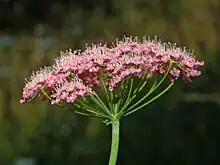Pimpinella major
Pimpinella major, common name greater burnet-saxifrage[1] or hollowstem burnet saxifrage,[2] is a herbaceous perennial plant in the genus Pimpinella belonging to the carrot family (Apiaceae).
| Pimpinella major | |
|---|---|
 | |
| Inflorescence of Pimpinella major, lateral view | |
| Scientific classification | |
| Kingdom: | Plantae |
| Clade: | Tracheophytes |
| Clade: | Angiosperms |
| Clade: | Eudicots |
| Clade: | Asterids |
| Order: | Apiales |
| Family: | Apiaceae |
| Genus: | Pimpinella |
| Species: | P. major |
| Binomial name | |
| Pimpinella major | |
| Synonyms | |
| |
Description
Pimpinella major reaches on average 30–100 cm (10–40 in) in height. The stem is hollow, deeply grooved, mostly glabrous, and generally branched and leafy.
The leaves are dark green, slightly glossy, ovate or oblong, short-stalked, feathery, more or less deeply cut, and usually pointed. Basal leaves have a petiole 20–60 cm (8–20 in) long.
The inflorescence has a diameter of 50–60 mm (2.0–2.4 in). The flowers, usually hermaphrodite, range from white to glowing rose or soft-pink and are gathered in umbels with 11 to 16 stalks.
The flowering period extends from June to August in its native habitat. The fruits are ovoid, 2–3 mm (0.08–0.1 in) long.
Subspecies
- Pimpinella major (L.) Huds. var. rubra Hoppe. ex Mérat
Also known as big red burnet, it is characterized by low growth and intense rose-colored petals. The stem is usually branched at the base, the branches are short and generally carry only one umbel.
- Pimpinella major var. rosea Lindeman
- Pimpinella major var. macrodonta (Pau) O. Bolòs & Vigo
- Pimpinella major var. orientalis (Gouam) Fi. et Paol.
- Pimpinella major var. dissecta (Sprengel) Fi. et Paol.
- Pimpinella major var. bipinnata G. Beck
Distribution
Pimpinella major is widespread in central Europe and in the Caucasus and it is naturalized in North America.
Habitat
It grows in burned forests, clearings, herb-rich areas, meadows, waysides, and wooded pastures. It prefers nutrient-rich substrate and chalk and limestone soils, at an altitude of 0–2,300 m (0–7,546 ft) above sea level.
Uses
The roots of Pimpinella major have been used internally in Austrian traditional medicine - as a tisane, in milk, or in herbal liqueurs - for the treatment of disorders of the respiratory tract, fever, infections, colds, and influenza.[3]
Gallery
 Close-up of flowers of P. major
Close-up of flowers of P. major Plant of Pimpinella major ssp. rubra
Plant of Pimpinella major ssp. rubra Figure from Deutschlands Flora in Abbildungen, 1796
Figure from Deutschlands Flora in Abbildungen, 1796 P. major from a herbarium
P. major from a herbarium Close-up of inflorescence of P. major
Close-up of inflorescence of P. major Leaves of P. major
Leaves of P. major
References
- BSBI List 2007 (xls). Botanical Society of Britain and Ireland. Archived from the original (xls) on 2015-06-26. Retrieved 2014-10-17.
- USDA, NRCS (n.d.). "Pimpinella major". The PLANTS Database (plants.usda.gov). Greensboro, North Carolina: National Plant Data Team. Retrieved 3 October 2015.
- Vogl, S; Picker, P; Mihaly-Bison, J; Fakhrudin, N; Atanasov, AG; Heiss, EH; Wawrosch, C; Reznicek, G; Dirsch, VM; Saukel, J; Kopp, B (2013). "Ethnopharmacological in vitro studies on Austria's folk medicine - An unexplored lore in vitro anti-inflammatory activities of 71 Austrian traditional herbal drugs". J Ethnopharmacol. 149: 750–71. doi:10.1016/j.jep.2013.06.007. PMC 3791396. PMID 23770053.
- Pignatti S. - Flora d'Italia - Edagricole – 1982 – Vil. II, pag. 190
- Tutin, T.G. et al. - Flora Europaea, second edition - 1993